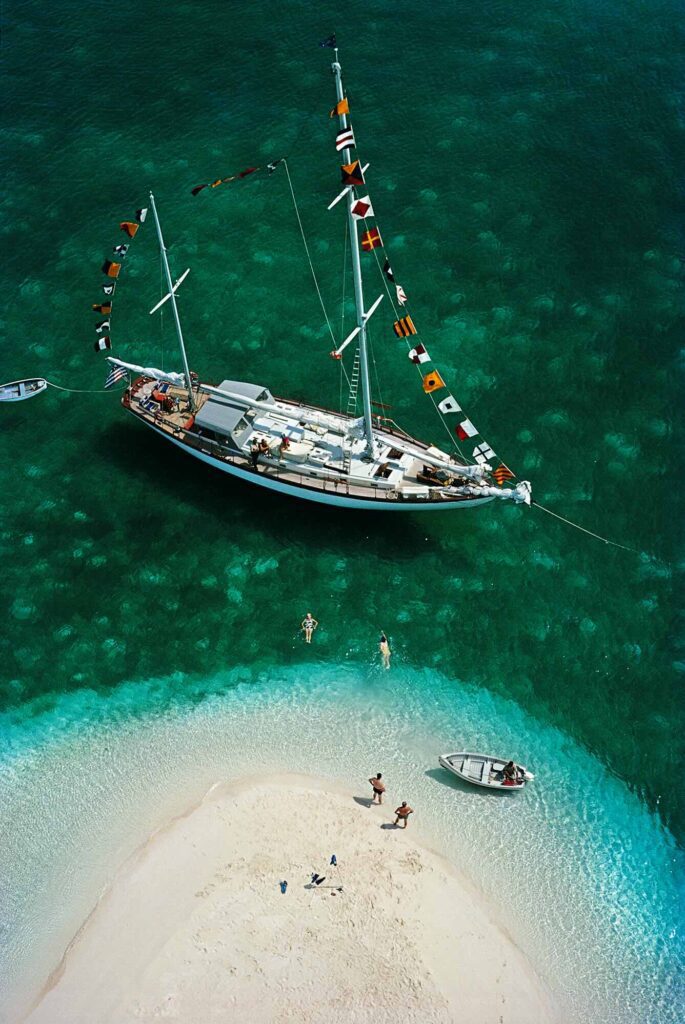
Capturing the Good Life
For over five decades, American photographer Slim Aarons captured the lifestyles of the rich and famous, presenting a golden age of wealth, beauty, and privilege through sunny portraits of post-war affluence. Born George Allen Aarons in 1916 in New York, he later became known as ‘Slim’ due to his lean, 6ft 4in frame. While Aarons would later surround himself with the glitterati, his beginnings in photography were far from luxurious.
A War-Weary Promise
After enlisting in the army at the start of the Second World War, he initially worked in the photography department at West Point Military Academy in New York before being sent overseas to cover conflict for the military publication Yank. Aarons was eventually wounded during the invasion of Anzio in Italy, and when the war ended, he set out for California, saying that if combat had taught him one thing, it was that the only beach to land on was one “decorated with beautiful, semi-nude girls tanning in a tranquil sun.” Weary of war, Slim Aarons decided that he had seen enough conflict and made a promise to photograph only the joys of life. And so he did.

Hollywood’s Darling
Aarons soon began assisting renowned Hollywood studio photographer Clarence Sinclair Bull at MGM Studios. In no time, he became a “darling” of the Hollywood elite; celebrities were charmed by the laid-back bon vivant whose photographs showed the likes of Marilyn Monroe and Humphrey Bogart at their most glamorous. As word of his vibrant photography began to spread amongst high society, Aarons soon became an insider. By the mid-50s, he began working as a freelancer for magazines such as Harper’s Bazaar, Life, Town & Country, and Vanity Fair, which opened more doors and was instrumental in shaping the stylish trajectory of his career.
Luxury and Leisure
Aarons’ photographs, whether showing subjects lounging by pools in Palm Springs, dining at villas in Capri, or sailing off Bermuda, offered readers a template for a life of luxury and leisure. Luxury and leisure became the essence of his photography. The elite enjoyed seeing how flattering they appeared in his photographs as Slim transformed his subjects into style icons. He would say,
“I don’t do fashion. I take photographs of people in their own clothes, and that becomes fashion.”
His images were not traditional, old-fashioned portraits of the rich; the subjects appeared sexy, and Aarons presented a world almost unbelievable in its elegance, contrasting with the turbulent political climate of the era.

An Insider Among the Elite
It wasn’t only Slim Aarons’ photographs that drew his subjects to him. To those he photographed, Slim was seen as ‘one of them’—a sophisticate, a man of the world who oozed charisma. He worked without photo equipment like strobes and flashes—preferring ‘available light’—and had no assistants. This allowed him the freedom to move around his subjects easily, building a level of mutual trust through intimacy. His movement while photographing was as nonchalant as the images themselves, as though they were snapped by pure coincidence. Aarons would at times spend an entire day with his subjects, and members of high society grew accustomed to his presence.
An Iconic Scene
His signature approach to photography soon came to be known as ‘conversation pieces,’ where sitters were shown interacting with their surroundings and each other. These “environmental portraits” highlighted the importance of the setting as much as the subject. This is evident in one of his most instantly recognized works, titled Poolside Pair. A well-dressed group of friends is shown enjoying a small party in the garden of a desert house in Palm Springs (Kaufmann House), designed by the renowned architect Richard Neutra. Nelda Linsk, the hostess in sunflower yellow, remembers how the picture came about:
“He [Slim Aarons] happened to be in Palm Springs and called me up one morning and said he wanted to take some swimming pool shots. I said, ‘Ok, come on over.’ He told me to call up a few of my friends. I called Helen (Dzo Dzo), of course, Liza Baron, and a couple of other friends. Slim came over about an hour later with a tripod and his camera. There were no assistants, no makeup artists, no hair stylists, nothing. We just put on the clothes we had in our closets. Very casual. In fact, if I’d known then what I know today, I might have dressed up a little more.”

A Dream of Leisure
Poolside Pairs, and Aarons’ photographs overall, grant the viewer a dose of escapism while reflecting his dedication to documenting the beauty of affluence. His fixation on details—the crisp blue swimming pool, the mid-century modern architecture, and the casual chic style of the subjects—gives the photograph an extra layer of texture and nuance. Of his ability to create dreamy moments, his long-time colleague and assistant Laura Hawk said,
“Slim had an almost childlike desire to idealize each mise-en-scène, to embellish the everyday scenarios he found with his idea—his fantasy—of what their world of leisure should look like. The portraits he created tell a story, and the arrangement of the visual details are the pieces of his fiction.”

Legacy of the Good Life
Slim Aarons, the undercover outsider within the elite, epitomized high society and old-money glamour throughout his illustrious career. His spontaneous, instinctive approach to photography created timeless depictions of the good life, which still remain highly influential today. The 1974 publication of A Wonderful Time: An Intimate Portrait of the Good Life solidified Aarons’ place as a pioneer of environmental portraiture and was later followed by the publications Slim Aarons: Once Upon a Time (2003), Slim Aarons: A Place in the Sun (2005), and Poolside with Slim Aarons (2007). Aarons passed away in 2006, leaving behind an enchanting body of work that shows his commitment to capturing “attractive people in attractive places doing attractive things.”

